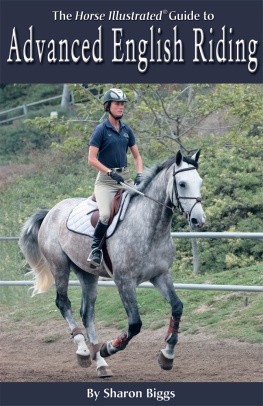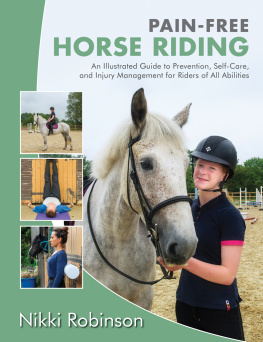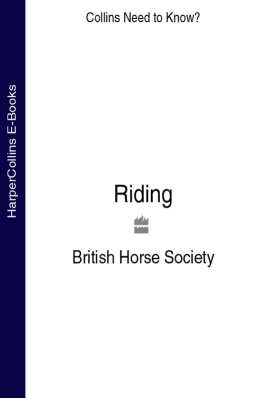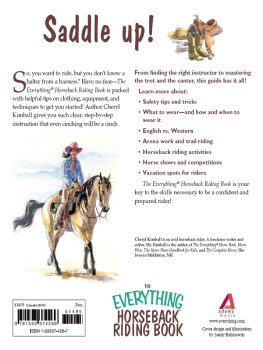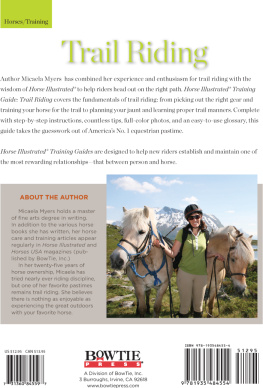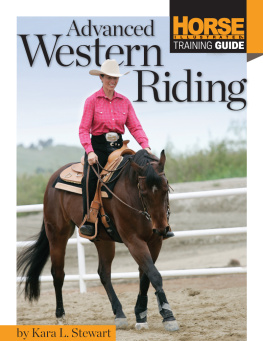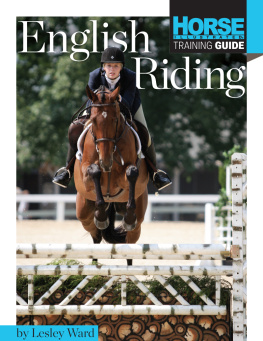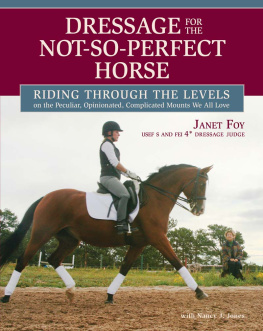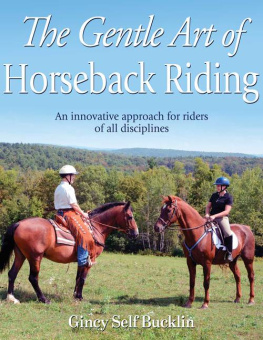
Karla Austin, Business Operations Manager
Nick Clemente, Special Consultant
Barbara Kimmel, Managing Editor
Jessica Knott, Production Supervisor
Amy Stirnkorb, Designer
Indexed by Melody Englund
Cover photo: Moira C. Harris
The additional photos in this book are by CLiX Photography, pp. 10, 22, 44, 54, 60, 66, 96, 123, 140, 144, 149, 150, 158, 160, 162, 168, 172, 175, 176, 181; Moira C. Harris, 12, 14, 15, 17, 18, 19, 20, 21, 23, 24, 28, 31, 32, 33, 34, 38, 41, 45, 47, 48, 51, 53, 56, 57, 59, 61, 62, 63, 64, 68, 69, 71, 74, 76, 77, 78, 80, 82, 84, 86, 88, 89, 90, 92, 93, 95, 98, 100, 101, 102, 121, 125, 126, 128, 132, 133, 134, 136, 137, 138, 152, 153, 154, 156, 170, 171, 179; Amber Heintzberger, 8, 27, 104, 106, 107, 109, 111, 113, 114, 115, 116, 142,145, 164, 166, 178; Lesley Ward, 30, 36, 118, 120, 124, 130, 147, 182, 188, 196
The horses in this book are referred to as she and he in alternating chapters unless their sexes are apparent from the activity discussed.
Copyright 2007 by BowTie Press
All rights reserved. No part of this book may be reproduced, stored in a retrieval system, or transmitted in any form or by any means, electronic, mechanical, photocopying, recording, or otherwise, without the prior written permission of BowTie Press, except for the inclusion of brief quotations in an acknowledged review.
Library of Congress Cataloging-in-Publication Data
Library of Congress Cataloging-in-Publication Data
Biggs, Sharon, 1966
The horse illustrated guide to advanced English riding / by Sharon Biggs.
p. cm.
Includes bibliographical references and index.
ISBN 978-1-931993-88-3
eISBN 978-1-937049-43-0
1. Horsemanship. I. Title.
SF309.B54 2007
798.23dc22
2007000320
BowTie Press
A Division of BowTie, Inc.
3 Burroughs
Irvine, California 92618
Printed and bound in Singapore
16 15 14 13 12 11 10 09 08 07 1 2 3 4 5 6 7 8 9 10
Dedication
For my parents, who encouraged me to become a rider and a writer; and for Mark, my lifelong riding partner.
Contents
Acknowledgments
No rider can make it through his or her career without being influenced by others, and an equestrian journalist is no different. I drew inspiration and gained expertise for this project, directly and indirectly, from several fine riders, including Sidley Paine, Christopher Bartle, Mark Waller, Richard Spooner, Kass Lockhart, Maryne Langer, Amber Heintzberger, Cindy Hale, Jane Weatherwax, Perry Wood, Richard Davidson, Karen Dixon, Mike Winter, Blyth Tate, and Timmie Pollock. Special thanks to models Laura Forrester, Katie and Joe Lifto, Lori Gabrelli, and Sherie Grant.
I also owe a debt of gratitude to Moira Harris, a wonderful editor, photographer, and good friend who encouraged me throughout this project.

Introduction
What is the definition of an advanced rider? More than at any other level, the advanced rider possesses a broad spectrum of skills at various stages of development. There are many levels of advancement. Of course, someone who has reached the dizzying heights of Olympic competition is an advanced rider, but a person who has learned the fundamentals of riding and gone on to own a horse of his or her own also can be an advanced rider. For me, the beginning advanced rider is someone who grasps the idea of good horsemanship and puts a great deal of time and effort into developing his or her seat and position. This book will help you develop those skills, and it is my hope that it will also help give you the skills to move on to the next step of your riding career, whatever the final level may be.


Honing the Seat and Position
All advanced riders want to achieve an independent position. Independence means that youre in total control of your seat at all times, no matter what your horse doeseven if she spooks or bucks. This seat allows you to move with any horses stride and with your legs lightly against your horses barrel, instead of gripping for balance. An independent seat also means you have the ability to maintain a steady contact with your reins, instead of using them as a way to stay on. Most of all, an independent position means you can time your aids correctly and use them effectively.
Checking Your Seat
To sit well, the rider has to be in a vertical line, over his own feet. Think about the best position to take if you are standing on the ground. You wont stand with your upper body pitched forward or back; youll stand with your knees slightly bent, and your hips will be over your feet so your feet, your hips, and your shoulders are aligned vertically. In the saddle, you want the middle of your foot (in the stirrup) to be underneath your hip, with your knee bent to whatever degree your kind of riding dictates. Your shoulders should be in line with your hips and your feet. You also must be balanced laterally, side to side, and have equal weight in the stirrups, with your shoulders parallel to the horses shoulders and your hips parallel to the horses hips.

Here is an example of a good dressage position: shoulders, hips, and feet aligned, with shoulders parallel to the horses shoulders and hips parallel to the horses hips.
As you put your leg on the horse and ask for driving energy from the hind legs, the energy must be able to travel through your seat, which says to the horse, I want you to stay in this length of stride, in this tempo, and in this gait. Then your hand has to receive and direct that energy. Riders often want to know how much leg pressure they should use. Remember that a horse can feel a fly on his coat, so your aids dont have to be huge to get a response; however, they have to mean something, or your horse will ignore you, and deservedly so. Therefore, whenever you use your legs, make sure that what you are asking for is clear and that you receive the correct response. Dont wait five seconds or more. Repeat the request. Your horse may require a tap from the whip, paired with the leg pressure, until she understands that you mean what you say. Spurs are also a good aid, but make sure your leg position is rock solid before you use them. Spurs used incorrectly can make your horse dull to or, worse, frightened of your leg. The rule of thumb regarding leg pressure is to use just enough to squash a ripe tomato against your horses side. And always keep your legs against your horse, close enough to feel her coat against your boots. Hold your legs there at all times, even when posting, because bouncing legs can cause your horse to become dull to your aids.
Good Hands
Although the different styles of English riding require a variety of hand positions, the overall purpose of the hands remains the same: to communicate your intentions to the horse (for example, slow down, turn here, stop). Your hands are, in effect, a telephone and a way to relay your requests. These requests must be clear and easily understood. If not, your horse will be confused and frustrated and will give you the wrong response or ignore you altogether. Tense, unfeeling, or jostling hands create an uncomfortable pressure that even the kindest horse will come to resent. Riders with light, open hands that barely touch the reins are just as at fault; although not as uncomfortable for the horse, lack of contact is tantamount to lack of conversation.
Next page
